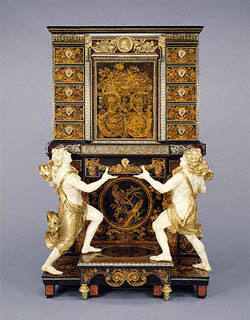• What is the first thing you notice when you look at this cabinet?
• How would you describe the figures at the front of the cabinet? What purpose do you think they serve in the design of this cabinet? How large is the cabinet? How large are the figures? What does that tell you about these figures?
• The figure on the left is Hippolyta, Queen of the Amazons, and the figure on the right is Hercules. What do we think of when we think of Hercules and a Queen of the Amazons?
• Look at the detail of the front door of this cabinet. What do you notice in the designs on this cabinet? What materials do you think this was made out of?
• If the figures of Hippolyta and Hercules are associated with strength, and the Cockerel of France is shown standing above the symbols of the Holy Roman Empire (the eagle) and Spain (the lion), what do you think this cabinet is meant to communicate?
• It is likely that this cabinet was made for Louis XIV of France, but there is no record of it in his belongings. It is thought that he might have given it as a gift to an ambassador from another country. What would this cabinet, with its symbols of triumph and strength, communicate to the leaders of the country who received it as a gift?
• On the door we see a cockerel, or young rooster, standing above an eagle and a lion. These images are symbols of countries. Today we think of the eagle as a symbol of the United States, but in the past it was the symbol of the Holy Roman Empire. What countries or states today use an animal as a symbol, and what message is it intended to communicate? |
This large cabinet on a stand is one of a pair (the other is now located in a private collection in Scotland) decorated with tortoiseshell, horn, brass, pewter, ivory, and panels of wood marquetry. The marquetry designs on the cabinet primarily show birds and flowers. The front of the stand is supported by two figures representing the Greek mythological heroes Hercules and Hippolyta, Queen of the Amazons, both of whom represent strength and bravery.
In its lavish decoration and propagandistic imagery, the cabinet celebrates the military victories won by Louis XIV during his reign. The marquetry on the central door of the cabinet shows the Cockerel of France standing triumphant above the Eagle of the Holy Roman Empire and the Lion of Spain and the Spanish Netherlands. This symbolizes France's victory over the combined forces of these countries in the Dutch War of 1672–1678. In addition to the symbolism on the marquetry panel, a portrait medallion at the top of the cabinet shows Louis XIV flanked by military trophies.
The flowers along the top of the cabinet are called fleurs-de-lis ("flowers of the lily"). They are the symbol of the French monarchy and make it clear that this piece was a royal commission; although no mention of it is made in the King's inventories, it is possible that the cabinet and its nearly identical pair were intended as royal gifts.
About the Artist
The name André-Charles Boulle is synonymous with the practice of veneering furniture with marquetry of tortoiseshell, pewter, and brass. Although he did not invent the technique, Boulle was its greatest practitioner, and the phrase "boulle work" is now used when describing this type of veneer. Called "the most skillful artisan in Paris" by his contemporaries, Boulle also specialized in floral marquetry in both stained and naturally colored wood and was known as a "painter in wood." Many of his designs are illustrated in a book of engravings published around 1720.
Before 1666, Boulle was awarded the title of master cabinetmaker; in 1672 the king granted him the royal privilege of lodging in the Palais du Louvre. In the same year, he achieved the title of cabinetmaker and sculptor to Louis XIV, king of France. This new title allowed him to produce furniture as well as works in gilt bronze such as chandeliers, wall lights, and mounts. Although strict guild rules usually prevented craftsmen from practicing two professions simultaneously, Boulle's favored position allowed him protected status and exempted him from these statutes.
About Marquetry
Used to decorate the smooth surfaces of furniture, marquetry is made from thin sheets (veneers) of wood, metal, or precious materials cut into a wide range of floral or figural patterns. Geometrically patterned marquetry is known as parquetry.
Although marquetry techniques were practiced during classical antiquity, their use lapsed during the Middle Ages. The craft was revived in Italy in the 1400s and spread northward, reaching France in the late 1500s. When the demand for luxurious furniture at the French court expanded in the following centuries, so too did the use of marquetry. It was used to cover the surfaces of desks, clocks, and even floors. In the 1600s, French furniture makers who specialized in veneering and marquetry were known as ébénistes because of their frequent work in ebony. ébébenistes, however, soon began creating designs using a variety of materials and techniques.
|
